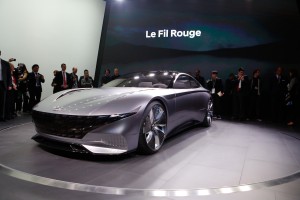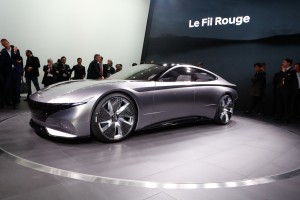
Hyundai showed the world its new design direction with the debut of Le Fil Rouge at the Geneva Motor Show.
Everything that’s old is new again.
It’s a loose interpretation of the Hyundai’s ‘Le Fil Rouge’ concept shown at the Geneva Motor Show today. Kia translates the name as “common thread” and believes that this new design will be the direction for the company going forward.
However, this forward-looking shift borrows from the company’s past as well.
“’Le Fil Rouge’ is a reinterpretation of Hyundai’s design DNA that originated from the brand’s historical Hyundai Coupe Concept in 1974,” said Luc Donckerwolke, executive vice president and head of Hyundai Design Center. “Building on our long history of creating distinctive and sporty character in vehicles, we will open a new era for Hyundai design.”
(To see our first drive in the 2019 Hyundai Nexo, Click Here.)
The new concept is an introduction to the brand’s latest approach in design: the ‘Sensuous Sportiness’ theme will be embodied by all future Hyundai vehicles, ranging from sedans to SUVs, according to Hyundai.
The goal of this new theme is to bring instinctive beauty, creating emotional value and desirability in Hyundai vehicles. The design mission is defined by the harmony between four fundamental elements: proportion, architecture, styling and technology.
The four fundamentals are designed to develop a vehicle that is appealing to the eye without gimmickry, provides comfort to passengers and offers the latest in safety and infotainment technology.
(Click Here for more about the expansion of offerings in the Sonata line-up.)
With ‘Le Fil Rouge’, Hyundai took a new approach called Light Architecture, to integrate a progressive identity into the brand’s design heritage. Light Architecture generates a dynamic look and forward motion effect for the vehicle. The front and the rear pillars as well as the roof are seamlessly blended into the overarching silhouette of the car – as though the car is drawn with a single line.
The exterior and interior are smoothly merged by the Tube Architecture, keeping the exterior’s sensuous and sporty character consistent inside the vehicle. The Tube Architecture’s principle is to create the same emotional value inside and outside the vehicle, while also allowing for a lightweight profile, Hyundai noted.
The interior design caters to the individual – and different – needs of both the driver and passengers. The front passenger seat maximizes comfort even on long-distance trips with more ample leg room, while the driver’s seat is designed to add to the fun on driving with optimized ergonomics. A wrap-around architecture emphasizes depth, creating a calm, spacious and comfortable travel environment for everyone in the car.
(To see more about Hyundai reporting lower profits in 2017, Click Here.)
“Our goal is to build a beloved brand by creating vehicles with heightened emotional value to reshape the landscape of car design,” said Sang-yup Lee, head of Hyundai Styling. “This is the foundation of our concept.”

